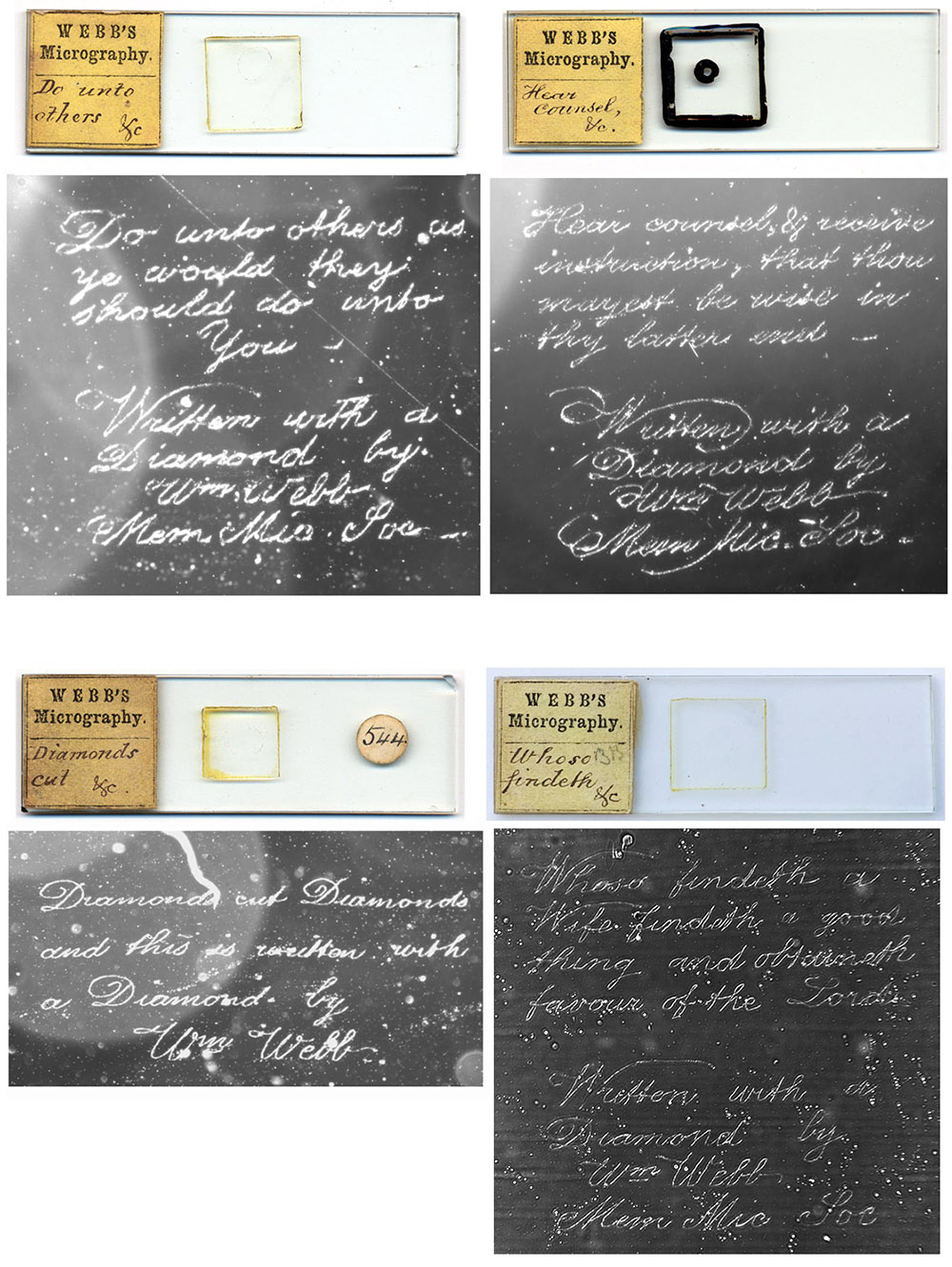
Figure 1. Examples of micro-engravings produced by William Webb, with his own trade labels. Images of the engravings were photographed using darkfield illumination, or brightfield with inverted image adjustment.
William Webb, 1815 – 1888
by Brian Stevenson
last updated May, 20254
Most antique microscopy enthusiasts are familiar with William Webb’s microscopic writings. For his most famous works, Webb used fine diamonds to etch words and pictures onto glass, examples of which are shown in Figures 1-6. These miniscule writings were often reckoned in “bibles per square inch”, that is, the number of times the entire King James’ Bible could be written in a square inch. Webb’s writings with dimensions as small as 59 bibles per square inch have been reported.
At the start of his microscopic writing career, ca. 1862, Webb wrote on paper (Figures 7-10). Those writings require an indirect lighting source, and are generally less detailed than his writings on glass. They were probably made for only a few years, and are very rare nowadays.
In order to make these tiny writings, Webb constructed a machine of levers and gears that reduced the movements of a hand-operated stylus to incredibly small dimensions. It is not known exactly what his machine looked like, as Webb reportedly destroyed it just before his death. But Webb’s machine probably resembled those made by William Peters and by Alfred McEwen, images of which may be seen in S. Warren’s 2009 Quekett Journal of Microscopy paper on diamond writing, and on pp. 336-339 of G. Turner’s The Great Age of the Microscope. Webb engraved upon the underside of the cover slip, not on the actual 1x3 slide, reporting that this permitted their use as tests of higher-powered objective lenses.

Figure 1. Examples of micro-engravings
produced by William Webb, with his own trade labels. Images of the engravings
were photographed using darkfield illumination, or brightfield with inverted image adjustment.
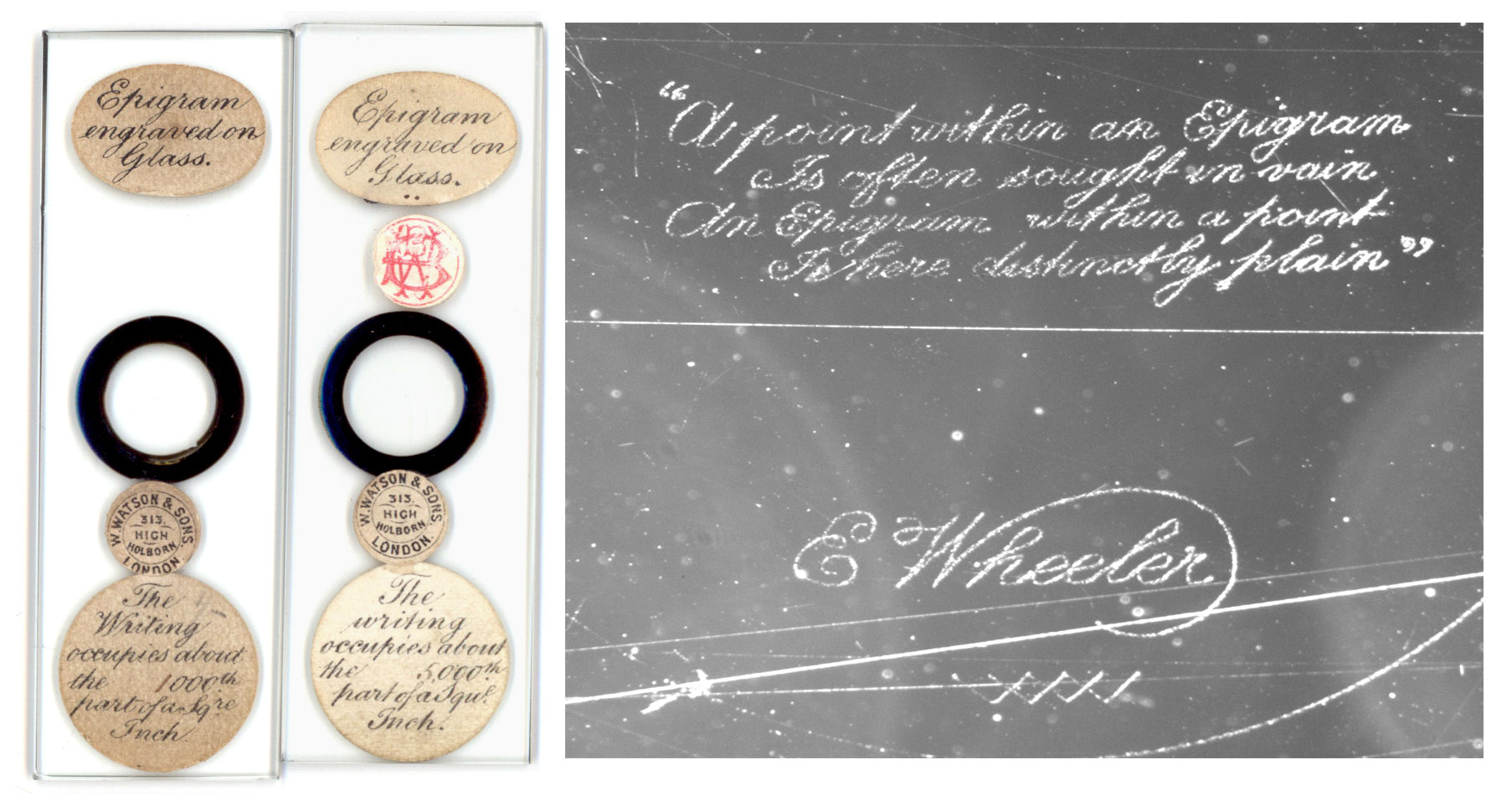
Figure 2. Two micro-engravings of an epigram,
made by Webb and retailed by Edmund Wheeler. Note that the handwriting,
including Wheeler’s “signature” is that of Webb (compare with Figure 1). The repeated “X” shapes below Wheeler’s name signify William Webb’s initials. Both microscope slides contain the same epigram, but at different sizes: one in 1/1000th of an inch, the other at 1/5000th of an inch. The printer made the lower labels for the slides without a stated dimension. This was later filled in, probably by the maker, Webb.
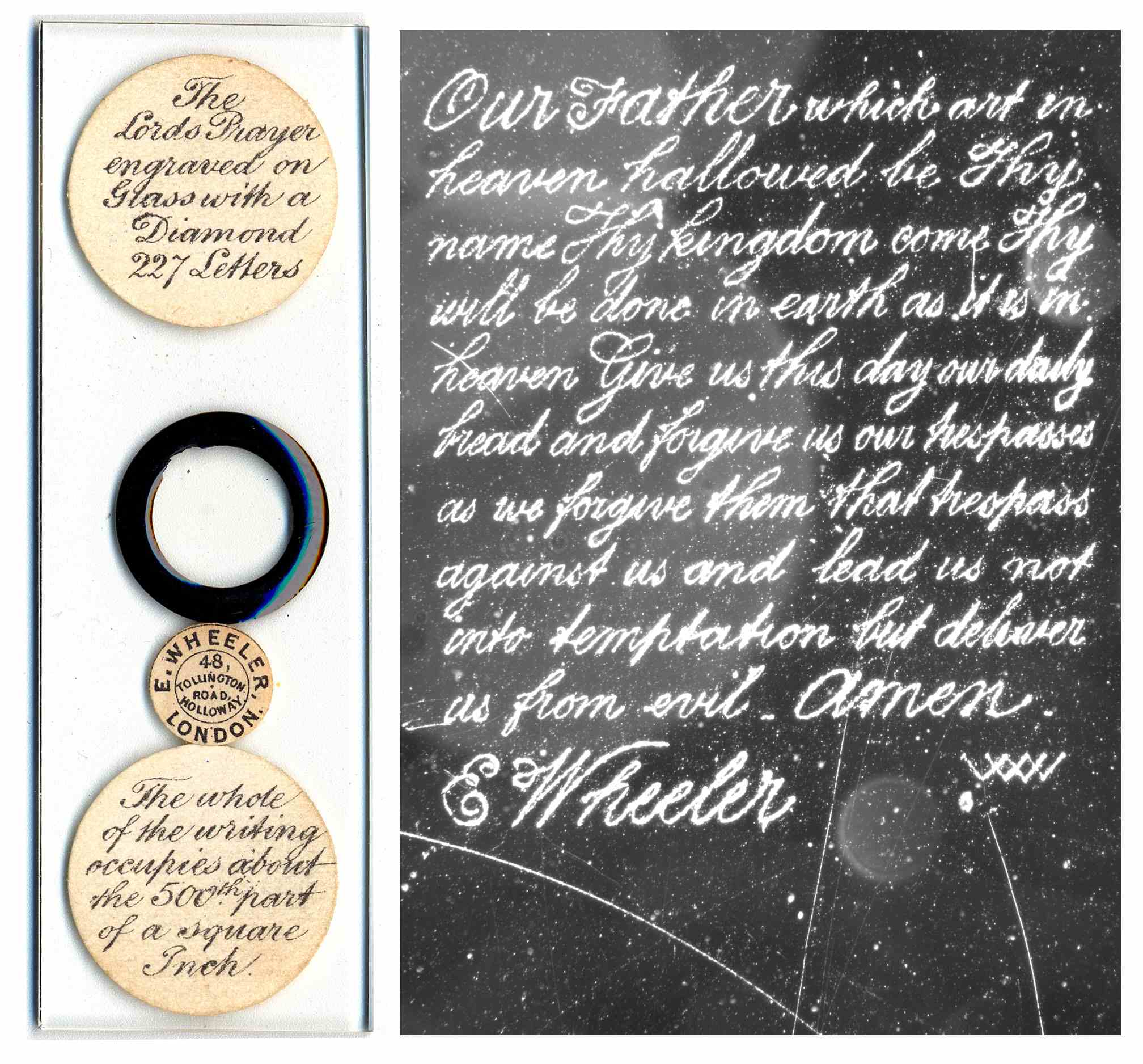
Figure 3. The Lord’s Prayer, produced by William Webb for Edmund Wheeler.
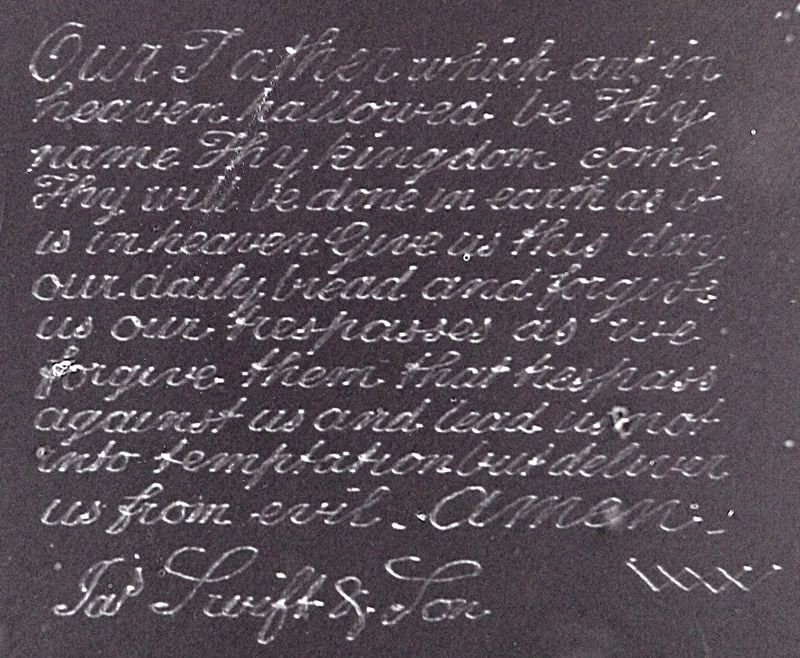
Figure 4. Another Lord’s Prayer, produced for sale by the James Swift and Son microscope company.
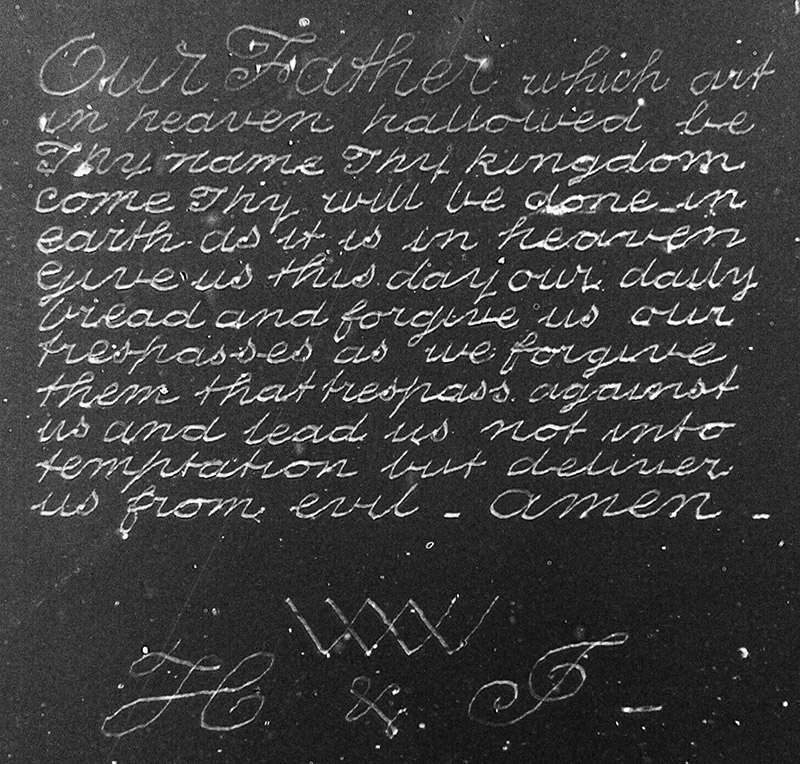
Figure 5. Yet another Lord’s Prayer, in this case, produced for sale by Horne and Thornthwaite ("H & T").

Figure 6A A quote from the Book of Proverbs, produced for sale by the John Browning optical company.
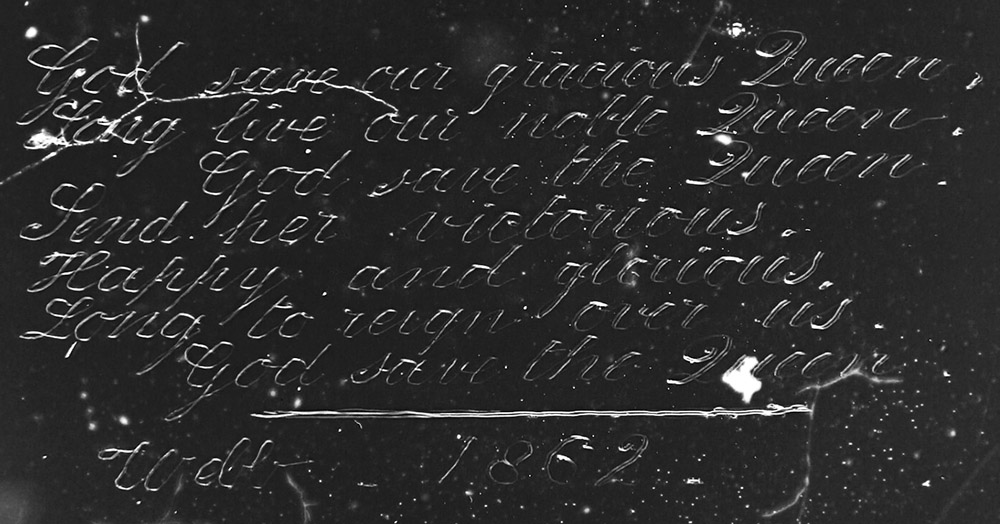
Figure 6B "God Save the Queen", produced by Webb in 1862. The slide has lost its original labels (not shown).
The Watson Centenary described William Webb as “an educated man, short with snow-white beard and hair and the remaining impression is of his perfect cleanliness. Everything about him was spotless and seemed to smell of soap.. He was a man with an appeal – he was a gentleman”.
William Webb was born during 1815 in St. Andrew’s Parish, London, probably the child born to William and Ann Webb, of Gray’s Inn, Holborn, on 11 June of that year. Father William was a “victualler”, i.e. a restaurant or tavern owner. The first nationwide census, of 1841, recorded the younger William as having been a “clerk”, still living in the parish of St. Andrew Holborn (Above the Bars). Some time prior to 1841, William took a wife, Mary Ann.
At the 1851 Great Exhibition of London, clerk William Webb presented a pantograph of his own devising, “an improved instrument for writing with pens and ink several copies simultaneously”. The mechanics of this invention probably evolved into his later reducing device. His address at that time was 34 Southampton Buildings, Chancery Lane, St. Andrew Holborn. The census of that same year confirmed this location, and also provided his occupation - a “shorthand writer”.
Mary Ann died at some point during the next ten years. The 1861 census shows William listed as a “widower”, working as a “tax collector” and being a “visitor” in the home of Caroline Richmond and her 5 children. Although the 1861 census, and that of 1851, records Caroline as being married, her husband was not present on either census night. Four children were born to Caroline between 1851 and 1861, so presumably the husband was home occasionally. The youngest Richmond child was 1 month old at the time of the 1861 census. Although we have not located a marriage record for William Webb and Caroline Richmond, she and several of her children later adopted the surname “Webb”.
On June 11, 1862, William Webb was elected to be a member of the Microscopical Society (London). His address at that time was the same as on the 1861 census, 3 Eaton Grove, Islington, London. A working-class man like William Webb would probably have needed a special edge in order to be admitted to this prestigious society. Wealthy men were welcome, as were also manufacturers of microscopes and other instruments. Webb’s amazing micro-engraving machine was probably the reason for his admission. At the following spring’s soiree, Webb “exhibited his microscopic writings, including the whole of the first chapter of St. John, written at a rate which the whole of the Old and New Testament would come twice over in the square inch. He also exhibited his micrometers with squares of the sixteenth millionth of an inch”.
Webb displayed his machine at the 1862 London International Exhibition. He submitted his entry too late to be included in the official catalogues. The Microscopical Society also exhibited Peters’ micro-engraving machine, but that of Webb appears to have stolen the show, possibly because Webb was also taking orders for micro-engravings. The Intellectual Observer reported some details on the process,
“Within the last few days Mr. Webb has placed his apparatus for executing microscopic writing on glass amongst the philosophical instruments in the northern gallery. The instrument may be described as a long perpendicular rod or lever carrying, at its lower end a pencil, which is traced over the original writing that is to be reproduced in miniature. The short arm of this lever is concealed in a box above, and acts upon a second lever, the arrangement being repeated until the motion, which originates with the hand below, is reproduced in the required degree of minuteness.
The extremity of the lever moving through this small space carries a diamond point, which is pressed against a thin plate of glass, producing by its action a micrograph of the design over which the long arm of the lever is traced below. The apparatus is a modification on that originally designed by Mr. Peters, and produces effects which have not hitherto been obtained. As examples of its power of executing fine writing, it may be stated that the entire of the Lord's Prayer may be easily written in a space of the one 2500th of an inch, and the entire of the first chapter of St. John, containing 51 verses and 4137 letters have been written in less than the one thousandth of an inch, a degree of minuteness which would enable the whole Bible to be written in the space of two square inches. Notwithstanding their excessive minuteness, the letters are easily legible under a high magnifying power, each line being perfectly distinct. The instrument is equally applicable to the engraving of linear designs. Amongst those that have been engraved, and which are exhibited by Mr. Webb, may be mentioned a long geometrical spiral in the one 2000th of an inch, and a comic illustration of a joke of Captain Marryat's which can be covered by the point of a pin.
The true value of the instrument, however, is shown in its application to the purposes of microscopic science; it is capable of producing Nobert's microscopic tests in bands of lines numbering 100,000 to the inch, and micrometers with divisions rising to the one 4000th of an inch, which, when crossed, produce perfectly distinct and sharp angled squares, each of one-sixteenth millionth of an inch in size (4000 X 4000 = 16,000,000).
As our notice may be the means of sending many to look at these astonishing results, it may save some trouble by stating, that having been introduced during the last few days, the micrograph will not be found in the catalogue, but its locality is readily ascertained as it is placed against one of the pillars of the northern gallery, on the railing overlooking the court below”.
Other evidence indicates that Webb originally planned to make money from his micro-engraving technique by printing tiny calling cards.
Fraser’s Magazine reported, “Mr. Peter's microscopic writing-machine, by which the Lord's Prayer can be written and read in the three hundred and fifty-six thousandth part of an inch, has attracted many visitors; but that constructed by Mr. Webb, which has been explained and worked by this gentleman, has afforded even greater interest. By it he has engraved the whole of the fifty-one verses of the first chapter of St. John in the 1/1054 of an inch, and a micrometer with squares absolutely perfect at their corners of 1/16000000 of an inch. He also exhibits an entire novelty, in the form of cards printed from copper plates engraved by him in the Exhibition. The writing on these cards, which is quite invisible to the naked eye, can be read with great distinctness under a microscope”.
The Intellectual Observer also stated, “In our September number (page 143), we gave an account of Mr. Webb's ingenious instrument for microscopic writing. The principle as then explained appears to be substantially the same as that of Mr. Peters's Microscopic Pantographs; and the results obtained by it are equally worthy of remark. At the date of our last notice Mr. Webb only exhibited specimens of minute writing on glass, but he has recently introduced a very elegant novelty in the shape of microscopic engraving and printing from copper plates. In this manner he has produced highly-finished copies of the Lord's Prayer, the Apostles' Creed, God Save the Queen, Rule Britannia, and sixteen lines of verse on the International Exhibition (see Figures 7-10). Many visitors have engraved their own address cards, by writing their names with a pencil on paper, and leaving the instrument to diminish and transmit the motion to the diamond point by which the letters were inscribed on a small copper plate.
To print from these delicate plates requires peculiar care and skill, but all the difficulties have been ably surmounted by Mr. Fautley, who has been working in conjunction with Mr. Webb, and the microscopic engraving, although scarcely visible to the naked eye, as a faint stain upon the paper, comes out with beautiful distinctness and regularity when placed on the stage of the microscope, and viewed with an inch or two-thirds object-glass. If the famous wizard Merlin should return to earth, and desire to print his magic book, Mr. Webb and his colleague would be able to reproduce the pages with ‘ample marge’
‘And every marge enclosing in the midst
A square of text that looks a little blot;
The text no larger than the limbs of fleas.’
They could indeed supply a diminished copy, as our readers will see when they receive the specimen we have had engraved for their delectation, and in which the letters are considerably less than the size indicated by the poet's zoological comparison. That this is no exaggeration they may learn by micrometrical measurement, which Mr. Webb assures us will show that some of the letters only measure the half-millionth of an inch! (footnote: A beautiful specimen of the engraving will be forwarded to readers who will send a directed envelope enclosing two postage stamps to Messrs. Groombridge and Sons, 5, Paternoster Row.) (see Figure 9).
Mr. Webb has shown us some blocks of glass nearly inch cubes, on which he had engraved microscopically, and from which he had printed specimens, using blacklead instead of ink. He also explained the difficulty in finding an ink that would deliver itself from such exceedingly minute cuttings on copper, but his present process is so successful that he has printed the Lord's Prayer from a copper-plate in a space not exceeding one-thousandth of an inch”.
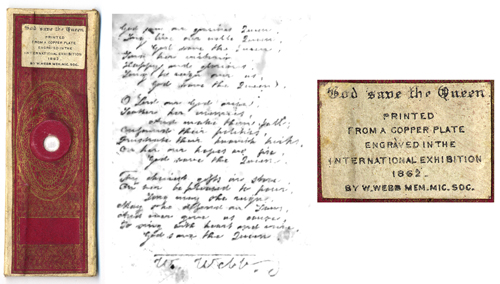
Figure 7.
A microscope slide with the lyrics
to “God Save the Queen”, printed by William Webb during the 1862 London
International Exhibition. Webb used his machine to engrave copper plates, which
were then used to transfer ink to paper. Cardboard slides were then made, for
viewing with indirect light. Due to the complexity of the process, these
micro-printings were far less refined than his engravings on glass (compare
with Figures 1-6).
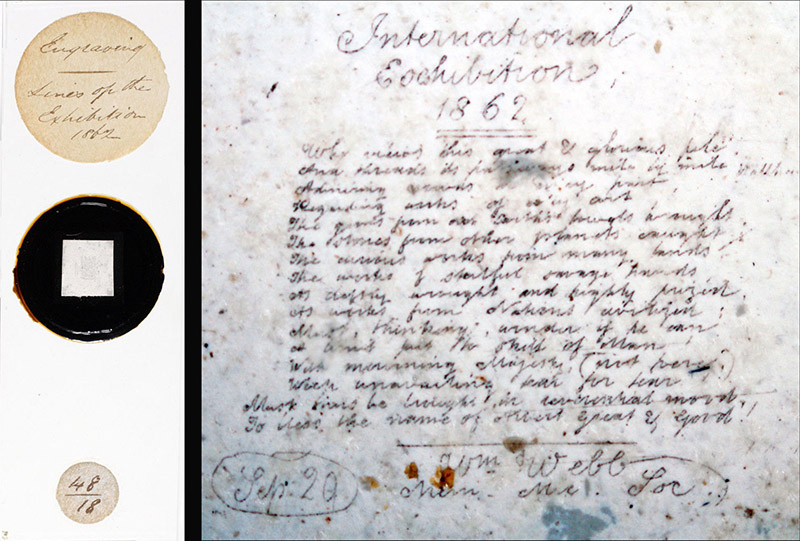
Figure 8.
A second microscope slide, similar to that shown in Figure 7, and also from the 1862 London International Exhibition. Adapted for nonprofit, educational purposes from an internet auction site.

Figure 9. Readers of the Intellectual
Observer who sent two postage stamps to the publisher received a microscope
slide with this micro-printing, made by William Webb. It reads “The
Intellectual Observer, One shilling Monthly, Groombridge & Sons, London”.
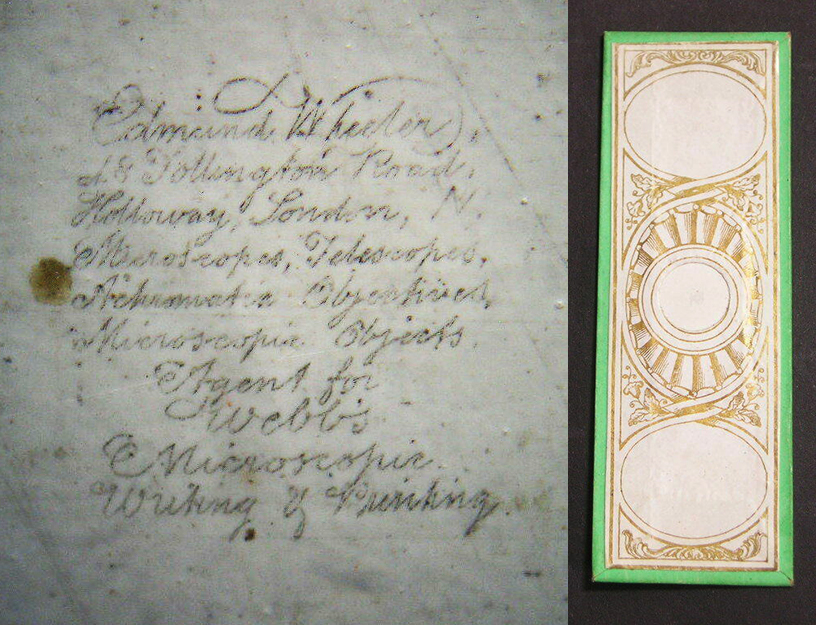
Figure 10. A microscopic writing by Webb, produced for retailer Edmund Wheeler.
The Intellectual Observer later stated, “Microscopic Address Cards.—The minute cards supplied by Mr. Webb are wonderful specimens of microscopic engraving and printing. You receive a Lilliputian glazed card, without the slightest trace of any inscription. A strong pocket lens shows two faint and delicate lines, impossible to decipher: but if the little curiosity is transferred to the stage of the microscope, and examined with an inch or two-thirds objective, you at once see a name and address in elegantly-formed letters, and greatly admire the skill by which so marvellous a result is obtained.
Mr. Webb addresses us a note, in which he says he has measured the first i in ‘shilling’, as it appears in one of the microscopic cards supplied to our readers, and he finds it ‘to be approximately the 1/500 X 1/1000 = 1/500000 of an inch’. The specimen which he engraved for us was by no means intended to represent the limit of perfection to which he has brought this curious art, but such as could be easily read with a moderate power by persons of ordinary sight. He sends us the ‘Lord's Prayer’, beautifully printed from copper, in which he states the letters are 1/1100 x 1/1100 = 1/500000 of an inch and he observes in his note, ‘startling as the above numbers appear at first sight, yet the letters are very large when compared with those which have been cut upon glass, some of which are only the forty millionth of an inch’. He adds, ‘In your September number you mentioned my chapter of St. John. That specimen has been measured by several gentlemen, who all agree in stating it to be the 1/21 X 1/24, or 1/1052 of an inch. The 4137 letters in that specimen, multiplied by 1054, give 4,360,398 letters to the square inch, while the whole of the Bible and Testament are said to contain only 3,566,400 letters, thus showing that at the rate in which the chapter of St. John is written, the whole Bible and Testament, and more than three-quarters of a million additional letters, would come into the square inch’. Mr. Webb also calls attention to the extreme minuteness of the particles of blacklead with which the lines of the finest writing on glass are filled by the gentleman who mounts his specimens. Their size, he says, would require at least ten figures to express it, and such figures are probably only a tenth of the number required to state the dimensions of Dr. Faraday's ruby gold.”
The Watson Centenary wrote, “William Webb .. forsook Law Courts reporting (Gurney’s shorthand system) in the hope that his engravings on glass would bring him fortune – but they didn’t”. On June 22, 1864, less than one and a half years after he appeared at the London Exposition, “Webb, William, microscopic merchant and shorthand writer, Windsor-rd. Upper Holloway, formerly of Chancery-la”, filed for bankruptcy.
Despite that setback, Webb did not cease his commercial production of micro-engravings. However that work was probably a supplement to his income, rather than the hoped-for primary occupation. Slides retailed by other dealers (Figures 2-6) were undoubtedly produced after 1864. Webb also made dated slides for Queen Victoria’s Golden Jubilee, in 1887. However, census records through the end of his life indicate that Webb’s primary occupation was shorthand writer.
The 1871 census found Webb and family at 247 High Holborn, St. Giles in the Fields, London. Caroline’s surname was now Webb, and the couple were listed as being married. A son, Alfred, was born to William and Caroline approximately 1868. Two of Caroline’s children, 16 year-old Clara and 14 year-old Laura, lived with William and Caroline, and were recorded as having the surname Webb. In 1875, Clara Webb married Henry Royle, and listed her father as being William Webb, short-hand writer. Similarly, Laura Ann Webb’s 1878 marriage record listed William Webb, shorthand writer, as being her father. At that time, the Webbs lived at 2 Featherstone Buildings, St. Andrew Holborn. Coincidentally, Andrew Ross had operated his microscope business from that address just two decades earlier.
On December 27, 1872, Webb made a presentation to the Quekett Microscopical Club in which he proposed his micro-engravings to be “the best, the most simple, and unerring tests for objectives” (Figure 10). He followed that presentation with another, on March 28, 1873, that complained of problems associated with the use of Nobert’s engraved lines as test objects. Reports of those meetings indicate that members of the audiences were not overly impressed with either Webb’s or Nobert’s lines. John Ingpen, in particular, preferred classic tests such as Podura scales or diatoms, but “thought that these miniatures of the Lord's Prayer would be welcomed as additions to what might be called ‘toy slides’.
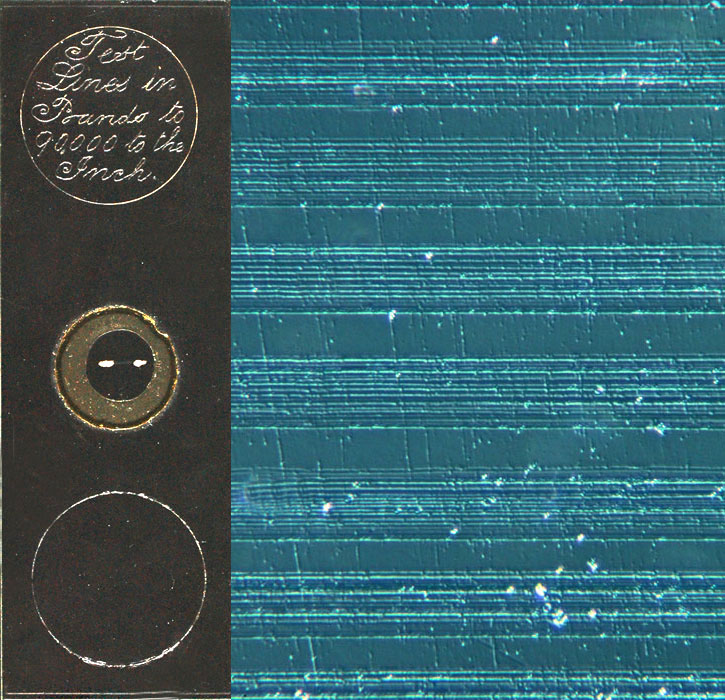
Figure 11. A micro-engraved ruling slide, made by William Webb. To the right is a magnified view of lines etched into the glass with his diamond engraving machine.
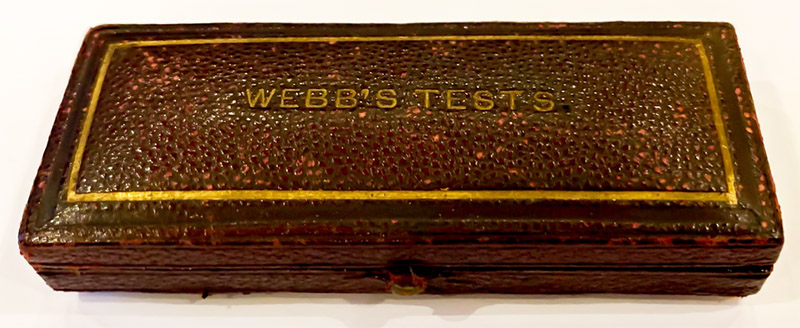
Figure 12. A case that held a Webb test engraving. Adapted for nonprofit, educational purposes from an internet sale site.
Webb made another, practical use of his micro-engraving machine in 1880. He produced glass slides with precise, square grids, for use as “finders”. In principle, one could map the position of a particular object on a slide, such as a diatom in a strew, by placing a grid slide (“finder”) over the specimen slide and noting the X- and Y-coordinates of the object. One could then readily find the object again, or one could mail the slide to a colleague and that person could easily find the object. Thomas Maltwood developed the most famous finder, in 1859, which used a microphotographed grid. Webb boasted that his finder improved upon that of Maltwood, in that his contained 16 squares in the space of one Maltwood square, allowing for greater mapping accuracy.
Census night, 1881, found William and son Alfred at their home at 14 Great Ormond Street, Finsbury, London. A woman who was probably his wife, Caroline, was a guest at an inn in Wotton St. Mary, Gloucestershire. Caroline was originally from that shire, so she may have been visiting relatives. Inexplicably, Caroline’s status was recorded as “unmarried”.
At the November 9, 1885, meeting of the Microscopical And Natural History Section of the Manchester Literary and Philosophical Society, Alfred Brothers presented on "Microscopic Writing”. Brothers exhibited a Webb slide of the Lord’s Prayer. Intriguingly, he also stated that W.H. Rideout had presented the Manchester society with “a machine for producing minute writing” ”about twenty years ago”. Brothers continued, “It seemed to me that as this instrument was purchased by Mr. Rideout at the great Exhibition in 1862, it might be the same with which the wonderful piece of writing, or perhaps it should be called engraving, referred to was executed”. He then spoke of writing to John B. Dancer (of microphotography fame) for more information. Dancer replied, “The microscopic writing on glass of the Lord's Prayer referred to in your letter was at one time in my possession, and was, I believe, presented by me to the Microscopical Section. It was obtained from Mr. Webb, and he was the same person who exhibited the microscopic writing machine at the great Exhibition of 1862. Mr. Webb died about ten or fifteen years ago, but I cannot give the exact date. I have a very strong impression that Mr. Rideout obtained the machine from him, which was sent by me to the Society. If able to find Mr. Rideout's letter it may confirm this”. Brothers reported that Dancer had not yet shown him that letter. Thus, it is possible that a second Webb micro-engraving machine existed (exists?).
The above article did not go unnoticed by the London microscopists. The Journal of the Royal Microscopical Society reported in February, 1886, “Mr. W. Webb, well known for his microscopic writing of the Lord's Prayer (the series of which commences at the rate of 3,616,791 letters to the square inch and extends to 212,746,216 letters, or at the rate of more than fifty-nine Bibles written in a square inch), has added a further novelty to the series, being a photograph and a writing of the Lord's Prayer side by side on the same slide, the former being photographed on the slide and the latter engraved on the cover-glass.
We observe that at a recent meeting of the Microscopical and Natural History Section of the Manchester Literary and Philosophical Society, a member stated, ‘Mr. Webb died about ten or fifteen years ago, but I cannot give the exact date’. Mr. Webb is, however, still alive, and as will be seen from the above, still engaged in microscopic writing”.
Just over two years later, “William Webb, male, 74 years, shorthand writer, of 89 Gray’s Inn Road, Pancras, died 22 July, 1888, at Royal Free Hospital”. The official cause of death was “morbus cordis, emphysema”. Morbus cordis means heart disease, apparently a phrase used for a natural death when the actual cause is unknown. The death was witnessed by William’s step-daughter, Clara. Webb was buried July 27 at the St. Pancras Parish Church.
The August, 1888, Journal of the Royal Microscopical Society reported, “We regret to have to record the death of Mr. Webb, the well-known engraver of the Lord's Prayer in characters so minute that the whole Bible could (in the case of one slide in our possession) be written fifty-nine times in a square inch. In this and similar feats Mr. Webb was without a rival, and his name may fitly be linked with that of Nobert as one of the great masters of the art of minute engraving with a diamond on glass”.
Caroline and Alfred were still living at 89 Gray’s Inn Road in 1891. Alfred, then 21, drove a horse-drawn cab. Caroline moved in with her daughter, Laura, by 1901, and died in 1904.
Acknowledgements
Many thanks to Steven Gill for generously sharing historical data and for constructive comments on the manuscript, and to Geoff Goldberg and anonymous collectors for providing images of William Webb’s slides.
Resources
Bracegirdle, Brian (1998) Microscopical Mounts and Mounters, Quekett Microscopical Club, London, pages 100 and 198-199
Bracegirdle, Brian, and Stanley Warren (1996) Diamond writing, 1853-1946, Quekett Journal of Microscopy, Vol. 37, pages 621-632
Burial record of William Webb (1888) St. Pancras Parish Chapel
Death record of William Webb (1888)
England census, birth, marriage and death records, accessed through ancestry.co.uk
Fraser's Magazine for Town and Country (1862) Vol. 66, November, pages 642-643
Intellectual Observer (1862) Vol. 2, pages 142-144, 298-299, 312 and 470
Journal of the Royal Microscopical Society (1886) Webb's Lord's Prayer, Series 2, Vol. 6, pages 147-148
Journal of the Royal Microscopical Society (1888) Death of Mr. Webb, page 654
Journal of the Royal Microscopical Society (1908), Part 5, page 396
Journal of the Quekett Microscopical Club (1872) Vol. 3, pages 146 and 177
The Law Journal Reports for the year 1864, Bankruptcy, Part 3 of Vol. 43, New Series Vol. 33, June 28, page 116
Marriage record of Clara Webb and Henry William Royle (1875) St. Giles, London
Marriage record of Laura Ann Webb and Robert Alfred Bristow (1878) St. Andrew Holborn, London
The Morning Post (1863) Thursday, April 9, 1863, The annual soiree of the Microscopic Society
Nature (1921) Obituary of Thomas Maltwood, Vol. 106, page 669
Official Catalogue of the Great Exhibition of the Works of Industry of All Nations (1851), third edition, page 93
Phin, John (1911) The Seven Follies of Science, third edition, van Nostrand, New York, page 142
Proceedings of the Manchester Literary and Philosophical Society (1885), Vol. 25, pages 74-76
Quarterly Journal of Microscopical Science (1862) election of William Webb to the Microscopical Society, pages 204
Turner, Gerard L’E. (1989) The Great Age of the Microscope, IOP Publishing, Bristol, UK
Warren, Stanley (2009) Diamond writing: an undercover report on William Webb, Quekett Journal of Microscopy, Vol. 41, pages 37-43
Watson Centenary 1837-1937 (1837) W. Watson and Sons, London. Reprinted by Savona Books, North Cotes, U.K. (http://www.savonabooks.free-online.co.uk/)
Webb, William (1872) The best, the most simple, and unerring tests for objectives, Journal of the Quekett Microscopical Club, Vol. 3, page 113
Webb, William (1872) Nobert’s tests, Journal of the Quekett Microscopical Club, Vol. 3, page 155<
Webb, William (1880) On an improved finder, Journal of Microscopy, Vol. 3, pages 750-753